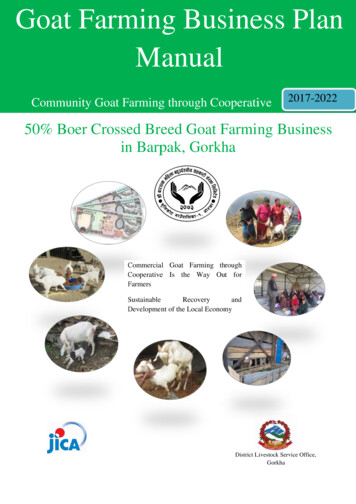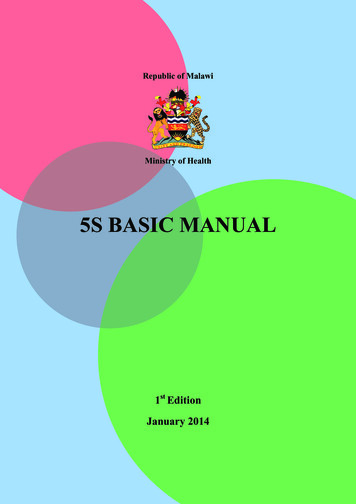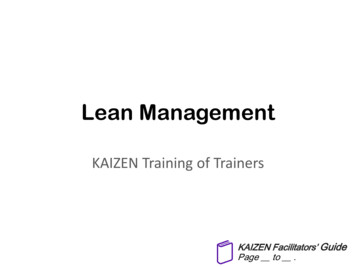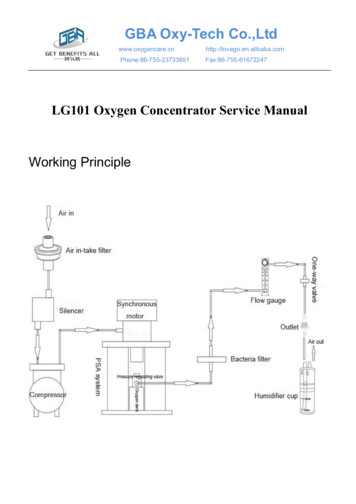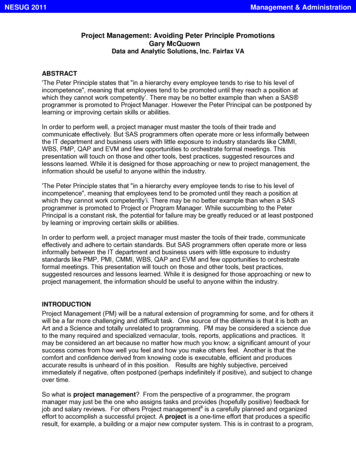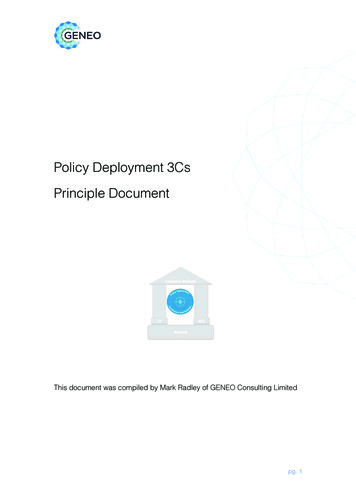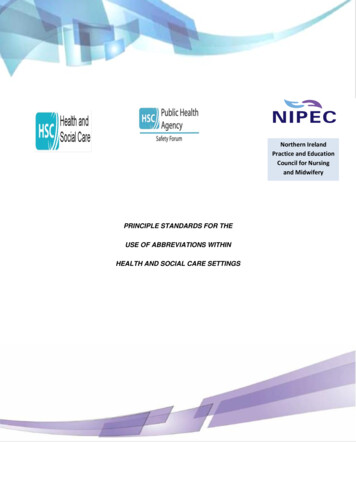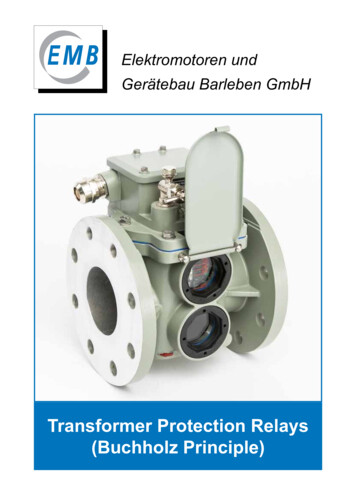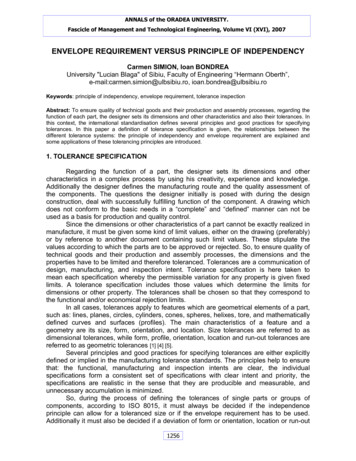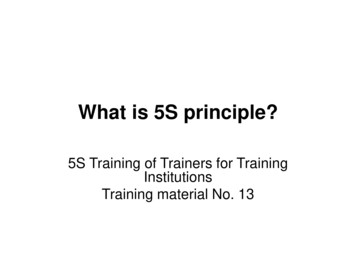
Transcription
What is 5S principle?5S Training of Trainers for TrainingInstitutionsTraining material No. 13
Aren’t you frustrated in your workplace?Oh, this positionmakes me tired !Where is thatdocument ?I cannot find it !Oh time is not enoughto complete this work!I cannot rememberwhat/how to next Why I am makingmistakes again andagainWhy we cannotcommunicateproperly?
Are youpositive thinker or negative thinker?3
Thinking negatively in inside boxand give-up?4
Work together and do somethingwith big positive attitude?5
Even you are positive thinker,you still need something to make your ideasrealisticYou need tools !6
There are useful tools5Sapproaches7
What is 5S ? 5S is a philosophy and a way of organizing andmanaging the workspace and work flow with theintent to improve efficiency by eliminating waste,improving flow and reducing processunreasonableness.It is for improvement ofworking environment8
What is 5S ? 5S activities are to create good workingenvironment through reduction of “Muri”,“Mura”, and “Muda” It help to have a basis of strong managementof workplace What is “Muri”, “Mura”, and “Muda”?– Muri : overburden, unreasonableness or absurdity– Mura : unevenness or inconsistency, primarilywith physical matter and the human spiritualcondition– Muda : activity which is wasteful or doesn’t addvalueSource: http://blog.5stoday.com/category/muri-mura-muda/
5S in Japanese/English/Swahili5S is literally five abbreviations of Japanese terms with 5 initials of rdizeSanifishaS-5SitsukeSustainShikilia10
Background on 5S activities The word “5S(five S)” was generalized in1980’s in manufacturing sector in Japan,as Toyota Production System (TPS)became famous in the sector and “5Sactivities” were set as one of the bases ofTPS Service industry started to used “5S” in1990’s
Background:- National Demonstration Project NDP was designed to test TQM approach forhealth care quality and safety improvement NDP was conducted in US (1989-1990) andJapan (2000-2004) Many private hospitals in Asia, Europe, andUS are practicing KAIZEN-TQM approachesfor health care quality, hospitals managementand safety improvement12
What 5S can do?13
Team work improvement througheveryone’s participation14
Identify Abnormalities15
Identify wastes and reduce the wastes16
The 7 wastesOverproductionOver onMr. Taiichi Ohno, Former President of Toyota Motors17
Improve productivities18
Improve safety19
If no 5S activities .Hesitate what to doRemember what /how to doLooking for necessaryitemsMaking mistake
Details of 5S approach21
5S: nS4:StandardizeS2:SetS3:Shine22
S1: Sort Focuses on eliminatingunnecessary items from theworkplace Categorize equipment,furniture, tool in yourworking place into thefollowing 3 categories1.2.3. NecessaryUnnecessaryMay not necessaryThis step will also help withthe “just in case” ine23Back to main
S1: Sorting activitiesEquipment, material, tools files, furniture etc. can becategorized based on the frequency of use!Equipment,materialstools etc. in yourwork placeMay need itItems only used occasionallyare in this categoryNot need itNeed itItems not used in current workprocess are in this categoryItems often use are in this category
Examples of “Sorting” Place “Red tag” for categorization of items toidentify unnecessary items Move unnecessary items( broken tools, obsoletejigs and fixtures, scrap and excess raw materialetc.) to central stored area Free up valuable floor space (Space utilization) Finding abnormality of equipment and tools (Outof order, missing parts etc.)25
26
S2: Set “Set” is based onfinding efficient andeffective storage ofnecessary items Apply “Can see, Cantake out, and Canreturn” philosophy This will save timeand energy to look 3:Shine27Back to main
S2: Setting activitiesThink not only “beatification.Need to consider workflow andarrange items Needed items Items often use(with currentwork process)Have consensus amongco-workers on where andhow to organize necessaryitemsUse 5S tools for properOrganization of itemssuch as Labeling Color coding Numbering Zoning etc.Arrange them properly based on“Can see, Can take-out, Canreturn” Philosophy
Example of “Setting” activities Labeling , numbering, zoning for clearidentification of storage areas to keepnecessary items Set necessary items matching withworkflow to minimize unnecessarymovement and transportation time29
SPROCESSMID.YEARSEPTEMBER2008After5S30
S3: Shine Cleaning up one’sworkplace daily sothat there is no duston floors, machinesor equipment. It will createownership and buildpride in the ne31Back to main
S3: Shining activities Clean floor, windows and walls. Clean and Maintain office automationmachines, medical equipment and tools,office furniture Develop and follow regular cleaningand Maintenance schedule
Example of “Shining” activities Daily sweeping and mopping of floor,bathroom, corridor etc. Regular cleaning and maintenance ofequipment and tools Periodical check for changes in equipmentand the service area such as: leaks,vibration, misalignment, breakage etc. IPC activities such as hand hygiene, wastesegregation are also part of shine33
34
S4: Standardize Maintain an environmentwhere S1 to S3 areimplemented in the samemanner throughout theorganization Give opportunities toemployees to take activepart in the developmentof these Shine35Back to main
S4: Standardizing activitiesS1S2S3Develop mechanism to standardizeS1-S3 implementation for continuationStandardization will leads equalization of activities “Production leveling and smoothing”Standardization is useful for; Easy implementation of S1 to S3 activities Equalization process output Everyone’s participation
Example of “Standardize”activities Work instructions, Standard OperatingProcedures (SOPs) Checklist development and regular usagefor SOPs Mechanism and format development forordering supplies, reporting etc Color coding for waste segregation Standardized common symbols37
38
S5 : Sustain Maintain S1-S4through discipline,commitment andempowerment It focuses ondefining a newmindset and astandard eShine39Back to main
S5: Sustainability activitiesPeople get bored if no changes.Need to develop a mechanism tomake staff exited and motivatedFurther ImprovementPrevent fallbackImprovementMeasure improvement with properperiodical monitoring
Example of “Sustain” activities Regular progress reporting Refresher training Periodical evaluation of 5S activities withproper advices for continuation andfurther improvements Appreciation, recognition and awardingon good 5S activities Reminder using 5S corner, new letters,good practice sheet etc.41
42
5S Conceptual FrameworkSORTSUSTAINSTANDARDIZESETSHINE43
5S is becoming popular forseven solid reasons1. Visible results enhance the generation of more andnew ideas2. The workplace gets cleaned up and betterorganized3. Hospital and office operations become easier andsafer4. Results are visible to everyone - insiders andoutsiders5. People are naturally disciplined6. People take pride in their clean and organizedworkplace7. As a result the company’s good image generatesmore better44
5S-KAIZEN-TQM PhasesPreparatoryphase3 month Situationanalysis TrainingofmanagersIntroductoryPhase6 month Trainingof staff Sorting Setting ShiningImplementation phase2 years Standardizing Sustaining Expansion areas to practice5S activitiesMaintenancephaseOn going Continue 5Scycle45
Target of 5STargets of Five-S include: Zero changeovers leading to product/ servicediversification Zero defects leading to higher quality Zero waste leading to lower cost Zero delays leading to on time delivery Zero injuries promoting safety Zero breakdowns bringing bettermaintenance46
Remember (1/2) 5S implementation can improve both workingenvironment and the service content.– Benefits on WEI will be better realized as you goalong the training. Go systematically to implement S1-S5:– Sort necessary & unnecessary items;– Arrange items according to work flow;– Make workplace and tools shining (dailycleaning);– Standardize “sort-set-shine” process; and– Workers acquire positive attitude to sustain &improve quality of health services.47
Remember (2/2) Effectiveness of 5S in improving health careservices content:– Complement to patient safety efforts, e.g., Minimizes chances of providing wrongmedicine, and treating wrong patients throughproper sorting (files, records) and appropriatelabeling (medicines, op-sites), as well as, useof checklist to avoid leaving items (such asgauze and scissors) by use of safe surgerychecklist.– Contribute to better continuum of care, e.g., Use of patient discharge checklists ensurecorrect linkages to needed services.48
Example of 5S activitiesBefore 5S (2009)After 5S (2010)Disorganized items in the store. Tooklong time to searching items neededUse labeling and organize items leadto minimize time for searching items,easy to control stocks49
Example of 5S activitiesBefore 5SDisorganized cabinet in a ward atUsangi DHAfter 5S50
Using color coding for Visual control of ampules in a ward at MNHGreen means“enough stock”Yellow means giving warning onRed means giving warning on“stock is getting less”“close to stock out and refill ”
Wrap-up Positive attitude is very important for implementationof 5S activities It is not “Cleaning Campaign” 5S activities are to create good working environmentthrough reduction of “Muri”(overburden),“Mura”(unevenness), and “Muda”(waste) 5S can identify and reduce “abnormalities” and“waste”, improve “team work”, “cleanness”, “safety”and “productivity” It is a basis of organization management
Thank you for listening !
The word “5S(five S)” was generalized in 1980’s in manufacturing sector in Japan, as Toyota Production System (TPS) became famous in the sector and “5S activities” were set as one of the bases of TPS Service industry started to used “5S” in 1990’s
